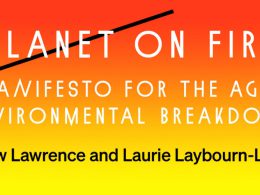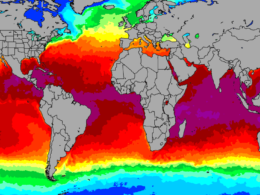The concentration of carbon dioxide in the atmosphere, the main cause of global warming, has reached a critical level. Carbon dioxide is released by the burning of coal, gas and oil, so called fossil fuels.
The recent measurement of the concentration of the gas at the Mauna Loa observatory in Hawaii shows it has reached 400 parts per million (ppm) in the atmosphere for the first time since human beings inhabited the planet.
As the evidence on climate change has grown, governments have nevertheless refused to take any meaningful measures to address the problem. Their paralysis in facing this emergency has become almost total since the financial crisis of 2008.
The graph below from the Scripps Institution of Oceanography in the USA, shows how the situation is now out of control. Going back nearly a million years, carbon dioxide concentrations have risen and fallen but were never high enough to destabilise global temperatures.
This changed dramatically 30 years ago with a very rapid increase to 400 ppm. The earth has experienced this concentration before, tens of millions of years ago, and it was then associated with sea level rises of between 5 and 40 metres (16 to 131ft) and average global temperatures rose by 3-4 degrees. This could be repeated with devastating consequences.
Also, the earlier rise to 400ppm concentration took place over thousands, or tens of thousands of years, allowing time for life to adapt. The present increase has happened in three decades and is accelerating all the time, making the future even more dangerous.
Global warming is not just a threat to future generations, the effects of climate change exist now in the form of extreme weather events.
The drought in the USA last year, combined with droughts and floods elsewhere, pushed up world food prices, which not only worsened world hunger but had more general economic effects. In Britain inflation was expected to fall rapidly due to austerity, but didn’t, partly because of sharply rising food prices.
As a result, take-home wages after allowing for inflation have continued to fall, prolonging the ’Great Recession’. In the USA, the cost of Hurricane Katrina and Superstorm Sandy that devastated the Wall Street finance district last year has been put at over $100 billion.
The evidence linking the extreme weather events the earth is experiencing to global temperature rise is increasing all the time, yet despite the huge human and economic costs already incurred, there has been no significant action taken by capitalist governments on global warming.
The opposite is in fact the case, with attempts to agree a new treaty to replace the ineffective Kyoto agreement being abandoned and a new drive launched to step up fossil fuel production in the USA, UK and elsewhere.
This is linked to producing gas from shale rock where there are enormous potential reserves which will add a vicious twist to spiralling global temperatures.
Fracking
Gas from shale, made by a process called fracking, could be even more deadly than conventional gas production. This is because methane gas is released, which is far more damaging to the environment than carbon dioxide. Fracking has also caused localised earthquakes and can lead to contamination of ground water.
Despite this, British chancellor George Osborne has just announced that he wants to create the world’s most generous shale tax (dodging) regime to stimulate production. He intends to cut the tax paid by shale gas manufacturers from 62% to 30%.
One justification given for this policy is that a shale industry will create thousands of new jobs, but a programme to develop renewable energy like wind, wave and solar would generate far more employment.
Osborne’s preference for fossil fuels over renewables is showing once again that what matters to the capitalist class is short-term profit and nothing must be allowed to stand in the way of this goal, even potential environmental destruction.
Competition between the main imperialist powers, whose governments primarily represent the multinational companies based inside their borders, has prevented any agreement being reached to tackle climate change.
The financial crisis of 2008 squeezed profits and made any agreement even less likely.
This deadlock clearly points to the need to remove the profit-based economic system and replace it with socialism that will create the conditions where environmental problems can be solved.
The main technical elements of a socialist programme will be:
- Rapid conversion to the use of renewable energy sources, such as wind, wave and solar power.
- Big expansion of public transport
- Conversion of the car industry to use renewable energy sources.
- More research into renewable energy such as clean coal technology.
To put this programme into effect will need the democratic public ownership of the energy and transport industries. The industrial sectors to be nationalised, or renationalised, will be the energy generating and distribution companies, vehicle manufacturers and bus and rail service providers.
Another key aspect in achieving environmental sustainability will be to increase the efficiency of the production of all manufactured goods and housing.
In fact, the need to reduce the intensity of energy use includes nearly all areas of the output of goods and services, so it will be essential to efficiently integrate the different sectors of the economy into a democratically determined plan of production, which will have environmental needs at its centre.
This in turn will require, for example, the public ownership of the approximately 150 big corporations that presently dominate British society.












